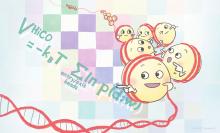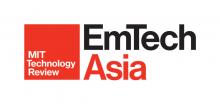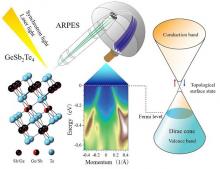Nanotech
News
31 May 2021
High-resolution genome structural analyses combined with large-scale simulations show the arrangements of the genome’s spool-like structures affecting gene expression.
18 May 2021
DGIST scientists have found a novel way to control magnetic spins in a localized space.
13 May 2021
The trick to extremely thin supercapacitors with improved performance is spraying graphene ink at an angle.
12 May 2021
Printing electronic circuits could soon get easier and cheaper.
13 Apr 2021
Scientists develop high performing electrocatalyst to synthesize ammonia in an effort to replace conventional eco-unfriendly methods
25 Mar 2021
Researchers at Kanazawa University report in Review of Scientific Instruments a newly developed atomic force microscopy approach for imaging biological samples and processes. The method offers higher frame rates and less disturbance of samples.
23 Mar 2021
The University of Tokyo researchers use information theory to show that the accepted biochemical model of bacterial chemical sensing is mathematically equivalent to the optimal solution, with implications for microbiology and robotics
17 Feb 2021
Researchers from DGIST have now found a way to keep living, wet cells viable in an ultra-high-vacuum environment, using graphene, allowing—like never before—accurate high-resolution visualization of the undistorted molecular structure and distribution of lipids in cell membranes. This could enhance our bioimaging abilities considerably, improving our understanding of mechanisms underlying complex diseases such as cancers and Alzheimer’s
10 Feb 2021
Researchers at The University of Tokyo discover a new law about how the complex network of phase-separated structures grows with time, which may lead to more efficient batteries and industrial catalysts
03 Feb 2021
A surprisingly simple method improves ‘drop casting’ fabrication of tiled nanosheets that could be used in next-generation electronic devices. All you need is a pipette and a hotplate.
12 Jan 2021
An atomic switch is bringing us closer to highly effective solid-state batteries for electric vehicles.
08 Jan 2021
Diamond is the hardest material in nature. But out of many expectations, it also has great potential as an excellent electronic material. A joint research team led by City University of Hong Kong (CityU) has demonstrated for the first time the large, uniform tensile elastic straining of microfabricated diamond arrays through the nanomechanical approach. Their findings have shown the potential of strained diamonds as prime candidates for advanced functional devices in microelectronics, photonics, and quantum information technologies.

11 Dec 2020
A joint research led by City University of Hong Kong (CityU) has built an ultralow-power consumption artificial visual system to mimic the human brain, which successfully performed data-intensive cognitive tasks. Their experiment results could provide a promising device system for the next generation of artificial intelligence (AI) applications.
19 Nov 2020
Scientists have found a way to control an interaction between quantum dots that could lead to more efficient solar cells.
19 Nov 2020
A repetitive DNA sequence that causes health risks when it malfunctions can now be watched inside living cells using a synthetic tool
03 Nov 2020
A recent study, affiliated with South Korea's Ulsan National Institute of Science and Technology (UNIST) has developed a tiny micro supercapacitor (MSC), being small as the width of a person's fingerprint.
11 Sep 2020
Measuring the temperature of objects at a nanometer-scale has been a long challenge, especially in living biological samples, because of the lack of precise and reliable nanothermometers. An international team of researchers has realized a quantum technology to probe temperature on a nanometer-scale, and have observed a ‘fever’ in tiny nematode worms under pharmacological treatment. This strengthens the connection between quantum sensing and biology and ushers in novel thermal imaging technologies in biomedical research.
18 Aug 2020
Nanoprodrugs have immense potential for cancer treatment, more so than conventional drug delivery systems. Researchers have, for the first time, developed a comprehensive study on the dynamics of the SN-38 nanoprodrug.
12 Aug 2020
Forty-five of the world’s most influential leaders and innovators participated in EmTech Asia. They discussed how emerging technologies will influence industries related to artificial intelligence, robotics, sustainability, healthcare, immersive media, and more.
10 Aug 2020
Researchers have found electrons that behave as if they have no mass, called Dirac electrons, in a compound used in rewritable discs, such as CDs and DVDs. The discovery of “massless” electrons in this phase-change material could lead to faster electronic devices.
09 Jul 2020
Scientists in Korea explain a new process that maximizes photon conversion in 2D materials, which could innovate photonic-based applications
18 Jun 2020
Scientists are looking for ways to make millions of molecule-sized robots swarm together so they can perform multiple tasks simultaneously.
18 May 2020
Researchers from Daegu Gyeongbuk Institute of Science and Technology develop a simple approach for controlling the otherwise random formation of cracks in flexible thin-film conductors, greatly increasing the durability of flexible electrodes and transistors against bending and folding.
13 May 2020
Hydrogen fuel cells made with coordination polymer glass membranes could produce as much energy as their liquid-based counterparts while adding strength and flexibility.
13 May 2020
Insights into a flipping crystal could further research into the development of autonomous robots.
12 May 2020
Researchers from Daegu Gyeongbuk Institute of Science and Technology(DGIST) have developed an innovative method that allows them to visualize up to tens of different proteins simultaneously in the same cell. This technology could help scientists elucidate the complex protein interactions involved in degenerative diseases such as Alzheimer’s, deepening our understanding of their mechanisms and allowing for early detection and treatment.
10 Apr 2020
A technology to further accelerate the commercialization of Colloidal Quantum Dot(CQD) Photovoltaic(PV) devices, which are expected to be next-generation photovoltaic devices, has been developed.
07 Apr 2020
Researchers at Kanazawa University and Tsukuba University report in Nanoscale that the physical properties of extracellular bacterial membrane vesicles are significantly diverse. The properties for a single type of bacterium as well as for different types are found to be highly heterogeneous.
Events
Sorry, no events coming up for this topic.
Researchers
Sorry, no researchers coming up for this topic.
- « first
- ‹ previous
- 1
- 2
- 3
Giants in history
Sorry, no researchers coming up for this topic.
























